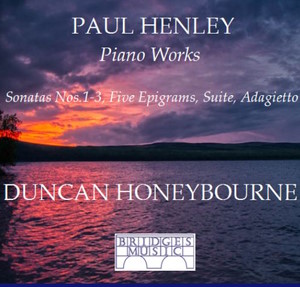
Paul Henley (b. 1959)
Works for Piano
Piano Sonata No. 1 (2005)
Piano Sonata No. 2 (2016)
Piano Sonata No. 3 (2020)
Five Epigrams (2019)
Suite (2002)
Adagietto (2020)
Duncan Honeybourne (piano)
rec. 2022, Sherborne School, Dorset, UK
Bridges Music BMCD04 [60]
On the strength of this and one other CD potential listeners should be tempted to see Bridges Music as the ‘home’ of British composer Paul Henley. The two discs share a superficial template – three sonatas and selection of other smaller or apparently less cogent pieces,
The present sampling of Henley’s melodic-tonal music for solo piano between 2000 and 2020 affords us a new chance to take stock. As for schemas of the sonatas we get variety not uniformity: one in three movements; a Lisztian single span; and a Third in four movements which, notably, are titled as if a suite (Processional, Moto perpetuo, Departure, Danza) rather than a single cohering structure. The terminology might suggest a slack miscellany; the listening experience is quite other.
From almost two decades ago the First Sonata declares a dramatic entry – it could hardly be more arresting. Then comes a contemplative mesmerising adagio and finally a return to the hectoring noble protestation of the first movement, but with a syncopated toe-tapping element. I had cause recently to mentioning Howard Ferguson as a voice in Malcolm Lipkin’s piano music (Lyrita). Here, the Ulster composer’s Piano Sonata has a much more direct presence.
Ten years after Henley’s First came its successor. The seven episodes are listed in the score. Again, there are heroic assertive aspects and dancing cells that add driven momentum and determination to the seven-minute work. The Third Sonata (2020) saw a move to a Rubbra-like ‘Processional’ with impressionistic tail-figures. This latter atmosphere carries over into a leery ‘Moto perpetuo’ whirlpool. The unrushed ‘Departure’ Adagio harks back to the ‘Processional’; Henley has a gift for these moody cortèges. The concluding ‘Danza’ is a dark piece of terpsichore; by no means a dance in the sunlight.
From the year preceding the Third Sonata come the Five Epigrams – enchanting impressions – not pretty-pretty but instead Poulenc in chilly mode or psychological thorn-bushes like John Ireland’s Ballade. The much earlier five-section Suite is from a clearer but not unclouded sky. Still, it brings in the sheaves in the shape of a sour heroism (redolent of Wilfred Josephs’ march for The Great War). To this aspect is mixed in grim fairy tales – the mood if not the text of Warlock’s Preludes and Lillygay. The last track is an Adagietto which has all the stern rhetoric and even placidity of Alwyn’s Fifth Symphony. Elsewhere this latter work is being played by Maltese pianist, Joanne Camilleri (a famous musical family).
In the torrent of recorded music that continues to defy the nay-sayers about the future of the compact disc, what marks out this music? It does not need to be unique – whatever that means in the context of music appreciation – but it does demand to serve a lowly (comfort) or exalted (inspirational) purpose, or both, to stand any chance. Henley attains that standard and we must hope to hear in future his Prelude for Orchestra and two string quartets. In different times I can imagine Henley achieving other great things in setting Hardy’s The Dynasts. I am sure he must count himself blessed that Duncan Honeybourne has lent skill and psychological oratory to this music. We can … even if a presentational blemish is that the timing of individual movements and works was omitted from this disc’s packaging.
Rob Barnett
Availability: Composer’s website


















